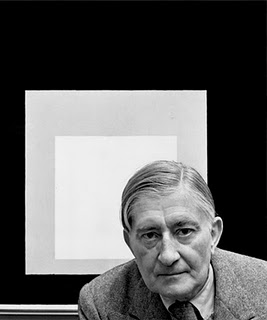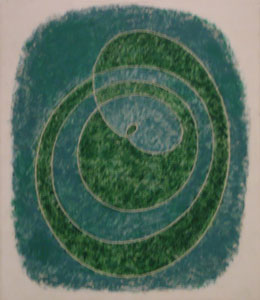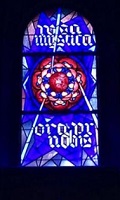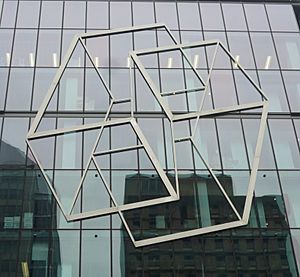Josef Albers facts for kids
Quick facts for kids
Josef Albers
|
|
|---|---|

Albers in front of one of his Homage to the Square paintings
|
|
| Born | March 19, 1888 |
| Died | March 25, 1976 (aged 88) |
| Education | Königliche Kunstschule zu Berlin, Königliche Bayerische Akademie der Bildenden Kunst, Bauhaus |
| Known for | Abstract painting, study of color |
|
Notable work
|
|
| Movement | Geometric abstraction |
| Spouse(s) | |
Josef Albers (March 19, 1888 – March 25, 1976) was a German-born artist and teacher. He was famous for his abstract paintings and for teaching art. He taught at important schools like the Bauhaus and Yale University. Many people consider him one of the most important art teachers of the 20th century.
As an artist, Albers worked in many different ways. He did photography, designed fonts (typography), created large wall paintings (murals), and made prints. He is best known for his abstract paintings and for his ideas about art. His famous book, Interaction of Color, was published in 1963.
Contents
About Josef Albers
Early Life in Germany
Josef Albers was born in 1888 in Bottrop, Germany. His family were craftsmen. His father worked as a housepainter, carpenter, and handyman. His mother came from a family of blacksmiths.
Growing up, Josef learned practical skills like engraving glass and working with plumbing. This made him good at handling many different materials. From 1908 to 1913, he worked as a schoolteacher in his hometown. He also trained to be an art teacher in Berlin from 1913 to 1915.
From 1916 to 1919, he started making prints in Essen. There, he learned how to make stained-glass with artist Johan Thorn Prikker. In 1918, he got his first big art job. He created a stained-glass window for a church in Bottrop. In 1919, he moved to Munich to study at the Academy of Fine Arts, Munich.
Joining the Bauhaus Art School
In 1920, Albers joined the Bauhaus in Weimar, Germany. The Bauhaus was a very famous art and design school. Even though he had studied painting, he joined the Bauhaus as a stained-glass artist in 1922. He saw stained glass as part of buildings and as its own art form.
The director of the Bauhaus, Walter Gropius, asked Albers to teach in 1923. He taught new students about the basics of handicrafts. This was because Albers had a strong background in working with different materials.
In 1925, the Bauhaus moved to Dessau. Albers became a full professor. That same year, he married Anni Albers, who was a student at the school. In Dessau, he designed furniture and continued working with glass. He taught alongside famous artists like Wassily Kandinsky and Paul Klee. Klee taught the art ideas in the glass workshops, while Albers taught the practical skills.
Moving to the United States
Teaching at Black Mountain College
In 1933, the Bauhaus school closed because of pressure from the Nazis. Many artists left Germany. Albers moved to the United States. Philip Johnson, an art curator, helped Albers get a job. He became the head of a new art school called Black Mountain College in North Carolina. He taught there from 1933 to 1949.
At Black Mountain, Albers taught many students who became famous artists. These included Ruth Asawa and Robert Rauschenberg. He also invited other important American artists to teach during the summer. Students said Albers was like "his own academy." He believed that when you are in school, you are a student, not yet an artist. But he strongly supported students expressing themselves once they became artists. During this time, Albers made many woodcut prints and studies of leaves.
Leading Design at Yale University

In 1950, Albers left Black Mountain College. He became the head of the design department at Yale University in New Haven, Connecticut. At Yale, Albers helped grow the graphic design program. He hired talented designers like Alvin Eisenman. Albers taught at Yale until he retired in 1958. Some of his notable students at Yale were Eva Hesse and Richard Anuszkiewicz.
In 1962, he received a special grant from the Graham Foundation. This was for an exhibit and lecture about his work. Albers also worked with Yale professor King-lui Wu to create designs for buildings. He designed unique geometric fireplaces for houses. He also designed the front of the Manuscript Society building at Yale.
During this time, he also designed abstract album covers for Enoch Light's Command LP records. His cover for the 1959 album Persuasive Percussion showed a pattern of small black disks. Albers continued to paint and write in New Haven with his wife, Anni Albers, until he passed away in 1976.
Album Covers for Command Records
Josef Albers designed album covers for Command Records from 1959 to 1961. His seven album covers used shapes like circles and grids of dots. These designs were unusual for his art at the time. These record covers are still popular today with music fans and design collectors. This was thanks to the teamwork between Albers and Enoch Light. Both were very passionate about their work.
Famous Artworks
Albers was a skilled designer, photographer, and printmaker. But he is most remembered for his abstract paintings and art ideas. He liked a very organized way of creating art. This is especially true in his series of hundreds of paintings and prints called Homage to the Square.
Homage to the Square
In this important series, which started in 1949, Albers explored how colors interact. He painted nested squares, one inside another. He usually painted on Masonite board. He used a palette knife with oil paints. He often wrote down the exact colors he used on the back of his artworks. Each painting has three or four solid colored squares nested inside each other. They come in different arrangements and sizes.
Murals
Albers also created large wall paintings called murals. In 1959, he made a gold-leaf mural called Two Structural Constellations. It was placed in the lobby of the Corning Glass Building in Manhattan. For the entrance of the Time & Life Building, he created Two Portals (1961). This mural was 42 feet tall and 14 feet wide. It had alternating glass bands in white and brown. These bands created an illusion of depth.
In the 1960s, Walter Gropius asked Albers to make a mural for the Pan Am Building. Albers reworked an earlier glass design and named it Manhattan. This huge abstract mural had black, white, and red strips. It was 28 feet high and 55 feet wide. It was installed in the building's lobby. It was removed around 2000 during a lobby redesign. However, Albers had left detailed instructions for the artwork. So, in 2019, it was recreated and put back in its original spot.
Other large works by Albers include Growth (1965), a painted mural. He also made Loggia Wall (1965), a brick relief. These were installed at the Rochester Institute of Technology. He also created Gemini (1972), a stainless steel relief in Kansas City, Missouri. For the Celanese Building in Manhattan, he made Reclining Figure (1972), a mosaic mural. This mosaic was destroyed in 1980. Albers also designed the mural Wrestling (1976) for the Mutual Life Centre in Sydney, Australia.
Color Theory
In 1963, Albers published his important book, Interaction of Color. This book teaches an experimental way to study color. He believed that color "is almost never seen as it really is." He also said that "color deceives continually." He suggested that the best way to learn about color is through experience, by trying things out and observing. The first edition of his book was very rare, with only 2,000 copies. It had 150 silk screen plates. The book has been republished and is even available as an iPad App today.
Albers taught color systems at the end of his courses and in his book. He described primary, secondary, and tertiary colors. He also explained the meanings he gave to specific colors on his triangular color model.
For his artworks, Albers carefully listed the exact paint colors and varnishes he used on the back of his pieces. It was as if the colors were parts of a science experiment. His work helped connect traditional European art with new American art. He was influenced by European art movements like Constructivism and the Bauhaus. His art had a big impact on American artists in the late 1950s and 1960s. "Hard-edge" abstract painters used his patterns and strong colors. Op artists and conceptual artists explored his ideas about how we see things.
Teaching and Influence
Albers taught his students about how colors interact. But he was also admired for teaching a general way to approach all art materials. Albers believed in learning by doing. He said, "what counts is not so-called knowledge of so-called facts, but vision – seeing." He focused on the process of making art. Even though their relationship was sometimes difficult, Robert Rauschenberg later said Albers was his most important teacher. Albers is considered one of the most influential teachers of visual art in the 20th century.
Notable Students of Albers
- Richard Anuszkiewicz (painter)
- Ruth Asawa (sculptor)
- Jane Davis Doggett (graphic designer)
- Eva Hesse (sculptor)
- Jay Maisel (photographer)
- Victor Moscoso (graphic artist)
- Robert Rauschenberg (painter and sculptor)
- Richard Serra (sculptor)
- Julian Stanczak (painter)
- Neil Welliver (painter)
Quotes by the Artist
- "Every perception of colour is an illusion... we do not see colors as they really are. In our perception they alter one another." (Around 1949, when Albers started his Homage to the Square paintings)
- "THE ORIGIN OF ART: The difference between what is physically real and how it makes us feel. THE CONTENT OF ART: Visual information of our reaction to life. THE MEASURE OF ART: How much effort is needed for the effect. THE AIM OF ART: To reveal and awaken vision." (1964, from his text "Homage to the square")
- "For me, abstraction is real, probably more real than nature. I'll go further and say that abstraction is nearer my heart. I prefer to see with closed eyes." (1966)
- "Art is not to be looked at. Art is looking at us... To be able to perceive it we need to be open. Therefore art is there where art meets us now. The content of art is visual expression of our relation to life. The measure of art, the ratio of effort to effect, the aim of art revelation and evocation of vision." (1968, in an interview)
- "I made true the first English sentence that I said when we arrived at Black Mountain College in November 1933. When a student asked me what I was going to teach I said: 'to open eyes'. And this has become the motto of all my teaching." (1970, in 'A conversation with Josef Albers')
Exhibitions
Solo Shows
- In 1936, Albers had his first solo art show in Manhattan at J. B. Neumann's New Art Circle.
- The Graphic Constructions of Josef Albers (December 8, 1969 – February 24, 1970) at MoMA, New York.
- Josef Albers at The Metropolitan Museum of Art: An Exhibition of His Paintings and Prints (November 19, 1971 – January 11, 1972) at the Metropolitan Museum of Art in Manhattan.
Group Shows
- documenta I (1955) and documenta IV (1968) in Kassel, Germany.
- The Responsive Eye (1965): A big Albers exhibition, organized by the Museum of Modern Art, traveled in South America, Mexico, and the United States from 1965 to 1967.
Shows After His Death
- Josef Albers, 1888–1976 (March 26 – April 19, 1976) at MoMA, New York.
- The photographs of Josef Albers: a selection from the collection of the Josef Albers Foundation (January 27 – April 19, 1988) at MoMA, New York.
- Painting on paper – Josef Albers in America (2010) at Pinakothek der Moderne, Munich; Centre Pompidou, Paris; and The Morgan Library & Museum, Manhattan. This show featured 80 oil works on paper, many never seen before.
- Josef Albers (2011) at Palazzina dei Giardini, Modena, Italy.
- Albers and Heirs: Josef Albers, Neil Welliver, and Jane Davis Doggett (2014) at the Elliott Museum, Florida.
- One and One Is Four: The Bauhaus Photocollages of Josef Albers (November 23, 2016 – April 2, 2017) at MoMA, New York.
- Josef Albers in Mexico (November 3, 2017 – April 4, 2018) at the Guggenheim Museum, New York.
- Albers and Morandi: Never Finished: works by Josef Albers and Giorgio Morandi (2021) at David Zwirner Gallery, New York.
Legacy
The Josef Albers papers, which are documents from 1929 to 1970, were given by the artist to the Smithsonian Institution's Archives of American Art in 1969 and 1970.
In 1971, Josef Albers started the Josef and Anni Albers Foundation. This is a non-profit group that he hoped would help "reveal and awaken vision through art." Today, this foundation manages the art collections of both Josef Albers and his wife Anni Albers. It also supports art shows and publications about their work. The foundation building is in Bethany, Connecticut. It has a research center, art storage, a library, and studios for visiting artists.
Another large part of Josef Albers' art collection is at the Josef Albers Museum in Bottrop, Germany, where he was born. Both the foundation and the museum work to keep the artist's reputation strong.
In 2019, his huge mural, Manhattan, was put back in the MetLife Building in New York. It had been gone for almost 20 years. When it was removed in 2000, a MetLife representative said it "doesn't work for us anymore." But two decades later, the mural is now seen as a vibrant centerpiece of the building. The director of the Albers Foundation said, "This is what art was for him: something that could affect you, maybe gave a little bit of joy to the lives of those people rushing to their trains or rushing out of the station to their workday."
See also
 In Spanish: Josef Albers para niños
In Spanish: Josef Albers para niños
- The Josef & Anni Albers Foundation
- Bauhaus
- Architype Albers (a typeface based on Albers' designs)
- Category:Albums with cover art by Josef Albers




